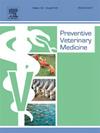Association of infrastructure and operations with antibiotic resistance potential in the dairy environment in India
IF 2.2
2区 农林科学
Q1 VETERINARY SCIENCES
引用次数: 0
Abstract
The dairy industry in developing countries is often associated with inappropriate use of antibiotics and the subsequent contamination of the environment with co-selectors of antibiotic resistance. However, the specific factors in dairy farm environments that influence antibiotic resistance levels and the subsequent exposure risks to farm workers are unknown. We examined the link between the infrastructure and operations of the dairy farm and the antibiotic resistance potential in India, which is the highest producer and consumer of dairy products globally. We sampled sixteen dairy farms in the Dehradun district, India, that varied in their herd size, infrastructure, and operational features during winter, summer, and monsoon. We collected samples of dung, manure, wastewater, manure-amended, and control soil from these farms. We quantified six antibiotic resistance genes (ARGs) (sul1, sul2, parC, mcr5, ermF, and tetW), an integron integrase gene cassette (intI1), and 16S rRNA gene copies as an indicator for total bacterial count. We observed that the infrastructure and the operations of the dairy farms were significantly associated with antibiotic resistance potential in the dairy environment. For example, with increased ventilation and exposure to external weather, the levels of sul2 (x͂=10−1.63) and parC (x͂=10−4.24) in manure increased. When farmers administered antibiotics without veterinary consultation, the relative levels of intI1 (x͂=10−2.36), sul2 (x͂=10−1.58), and tetW (x͂=10−3.04) in manure were lower than the cases where professional advice was sought. Small-scale farms had lower relative ARG levels than medium- and large-scale farms, except for mcr5 (x͂=10−3.98) in wastewater. In different sample types, the relative ARG levels trended as manure-amended soil (x͂=10−2.34) > wastewater (x͂=10−2.90)> manure (x͂=10−3.39)> dung (x͂=10−2.54). ARGs correlated with the marker for horizontal gene transfer, intI1, which exacerbates overall antibiotic resistance levels. Exposure assessment showed that the agriculture farm workers working in manure-amended agriculture farms are exposed to higher antibiotic resistance potential than dairy farm workers, who manually handle dung. Our study showed that the link between the dairy infrastructure (ventilation and floor type) and operations (scale of operation and veterinary consultation) and the antibiotic resistance potential in the dairy farm environment was statistically significant. This knowledge paves the way for designing interventions that can minimize the antibiotic resistance potential on dairy farms and in affected environments and thus reduce the public health burden of antibiotic-resistant infections in the dairy industry and dairy workers in India.
印度乳制品环境中具有抗生素耐药潜力的基础设施和操作协会
发展中国家的乳制品行业往往与抗生素的不当使用以及随后的抗生素耐药性共同选择物对环境的污染有关。然而,奶牛场环境中影响抗生素耐药性水平和随后对农场工人暴露风险的具体因素尚不清楚。我们研究了印度奶牛场的基础设施和运营与抗生素耐药性之间的联系,印度是全球最大的乳制品生产国和消费国。我们对印度德拉敦地区的16个奶牛场进行了采样,这些奶牛场在冬季、夏季和季风期间的畜群规模、基础设施和运营特征各不相同。我们收集了这些农场的粪便、粪便、废水、粪便改良和控制土壤样本。我们量化了6个抗生素耐药基因(ARGs) (sul1、sul2、parC、mc5、ermF和tetW)、一个整合子整合酶基因盒(intI1)和16S rRNA基因拷贝数,作为细菌总数的指标。我们观察到,奶牛场的基础设施和运营与奶牛场环境中潜在的抗生素耐药性显著相关。例如,随着通风和暴露于外部天气的增加,粪便中sul2 (x =10−1.63)和parC (x =10−4.24)的含量增加。在不征求兽医意见的情况下使用抗生素时,粪中intI1 (x =10−2.36)、sul2 (x =10−1.58)和tetW (x =10−3.04)的相对水平低于征求兽医意见的情况。小规模养殖场的相对ARG水平低于中型和大型养殖场,但废水中的mcr5 (x =10−3.98)低于中型和大型养殖场。在不同样品类型中,相对ARG水平的变化趋势为:粪化土壤(x =10−2.34)>; 废水(x =10−2.90)>; 粪土(x =10−3.39)>; 粪土(x =10−2.54)。ARGs与水平基因转移标记intI1相关,这加剧了整体抗生素耐药性水平。暴露评估表明,在粪便改良农场工作的农场工人比手工处理粪便的奶牛场工人暴露于更高的抗生素耐药性潜力。我们的研究表明,奶牛场基础设施(通风和地板类型)和经营(经营规模和兽医咨询)与奶牛场环境中抗生素耐药性潜力之间的联系具有统计学意义。这一知识为设计干预措施铺平了道路,这些干预措施可以最大限度地减少奶牛场和受影响环境中的抗生素耐药性潜力,从而减轻印度奶牛业和奶牛业工人抗生素耐药性感染的公共卫生负担。
本文章由计算机程序翻译,如有差异,请以英文原文为准。
求助全文
约1分钟内获得全文
求助全文
来源期刊

Preventive veterinary medicine
农林科学-兽医学
CiteScore
5.60
自引率
7.70%
发文量
184
审稿时长
3 months
期刊介绍:
Preventive Veterinary Medicine is one of the leading international resources for scientific reports on animal health programs and preventive veterinary medicine. The journal follows the guidelines for standardizing and strengthening the reporting of biomedical research which are available from the CONSORT, MOOSE, PRISMA, REFLECT, STARD, and STROBE statements. The journal focuses on:
Epidemiology of health events relevant to domestic and wild animals;
Economic impacts of epidemic and endemic animal and zoonotic diseases;
Latest methods and approaches in veterinary epidemiology;
Disease and infection control or eradication measures;
The "One Health" concept and the relationships between veterinary medicine, human health, animal-production systems, and the environment;
Development of new techniques in surveillance systems and diagnosis;
Evaluation and control of diseases in animal populations.
 求助内容:
求助内容: 应助结果提醒方式:
应助结果提醒方式:


